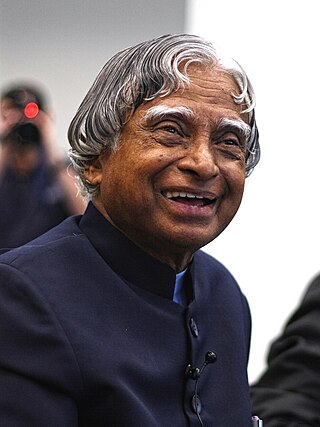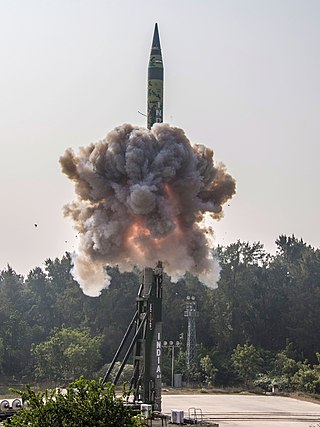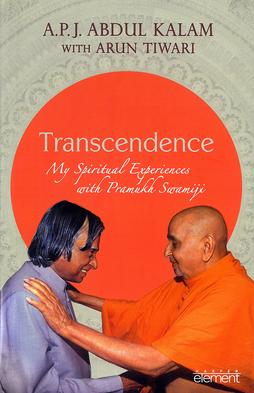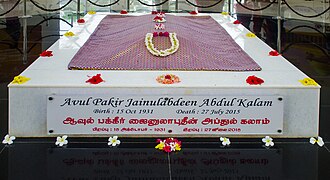
Avul Pakir Jainulabdeen Abdul KalamBR was an Indian aerospace scientist and statesman who served as the 11th president of India from 2002 to 2007. Born and raised in a Muslim family in Rameswaram, Tamil Nadu, he studied physics and aerospace engineering. He spent the next four decades as a scientist and science administrator, mainly at the Defence Research and Development Organisation (DRDO) and Indian Space Research Organisation (ISRO) and was intimately involved in India's civilian space programme and military missile development efforts. He thus came to be known as the Missile Man of India for his work on the development of ballistic missile and launch vehicle technology. He also played a pivotal organisational, technical, and political role in India's Pokhran-II nuclear tests in 1998, the first since the original nuclear test by India in 1974.

Wings of Fire (1999), is the autobiography of the Missile Man of India and the former President of India, Dr. A. P. J. Abdul Kalam. It was written by him and Arun Tiwari.
Dr. Abdul Kalam Island, formerly known as Wheeler Island, is an island off the coast of Odisha, India, approximately 150 kilometres (93 mi) east of the state capital Bhubaneswar. The island was originally named after English commandant Lieutenant Hugh Wheeler. On 4 September 2015, the island was renamed to honour the former Indian president, Dr. A. P. J. Abdul Kalam.This island is also known as Area 51 of India. The Integrated Test Range missile testing facility is located on the island, and serves as the test facility for most of India's missiles such as the Akash, Agni, Astra, BrahMos, Nirbhay, Prahaar, Prithvi, Shaurya Missile, Advanced Air Defence, Prithvi Air Defence, SMART missile and ASAT missiles.

Dr APJ Abdul Kalam Road is a road in New Delhi, India. It lies at the north-east end, stretching from the 'Taj Mansingh Hotel' at the roundabout of Mansingh Road, Shahjahan Road, Humayun Road, Prithviraj Road and a road to Khan Market in the north-east. At the south-west end it stretches up to the crossing at Mustafa Kemal Atatürk Marg and Safdarjung Road junction.

The Indian Ballistic Missile Defence Programme is an initiative to develop and deploy a multi-layered ballistic missile defence system to protect India from ballistic missile attacks. It was launched in 2000 after the Kargil War by the Atal Bihari Vajpayee government. Testing was carried out and continuing as of 2006, and the system was expected to be operational within four years according to the head of the country's missiles development programme, Vijay Kumar Saraswat.

Agni-V is a land based nuclear MIRV-capable Intercontinental Ballistic Missile (ICBM) developed by the Defence Research and Development Organisation (DRDO) of India. The missile has a range of more than 7,000 km. It is a three-stage, road-mobile, canisterised and solid-fuelled ballistic missile. It is one of the fastest missiles in the world, reaching speeds up to 29,400 km/h.
A Sivathanu Pillai is an Indian scientist who formerly served as Honorary Distinguished Professor at Indian Space Research Organisation (2015–2018) and an honorary professor at IIT Delhi in the Department of Mechanical Engineering (2015–2016) and a visiting professor at Indian Institute of Science (2014–2015).

The HSTDV is an unmanned scramjet demonstration aircraft for hypersonic flight. It is being developed as a carrier vehicle for hypersonic and long-range cruise missiles, and will have multiple civilian applications including the launching of small satellites at low cost. The HSTDV program is being run by the Defence Research and Development Organisation (DRDO).

The Senate House is the administrative centre of the University of Madras in Chennai, India. It is situated in Wallajah Road, along Marina Beach. Constructed by Robert Chisholm between 1874 and 1879, the Senate building is considered to be one of the best and oldest examples of Indo-Saracenic architecture in India.

S. M. Khan was an Indian Information Service officer of Government of India. Khan, a 1982-batch IIS officer, had a long tenure with Central Bureau of Investigation as its spokesperson and Press Secretary to then President of India A P J Abdul Kalam, and served as Director of Jamia Hamdard Residential Coaching Academy.

Transcendence: My Spiritual Experiences with Pramukh Swamiji is a book written by A. P. J. Abdul Kalam, the 11th President of India and a pioneering scientist. Co-authored by Professor Arun Tiwari and published by HarperCollins India, the book describes Kalam's spiritual experiences with and reflections on Pramukh Swami Maharaj, the guru and spiritual leader of the BAPS Hindu organization. Kalam recounted the spiritual transformation he experienced during his fourteen-year association with Pramukh Swami, described the inspiration he obtained from Pramukh Swami's leadership of BAPS, and expressed his vision for a society in which science and spirituality are fused. Kalam stated that he saw in Pramukh Swami "a true embodiment of transcendence," and titled the book to reflect his belief that Pramukh Swami is gunatit, a term signifying transcendence of ephemeral qualities and the modes of nature.

The Dr. A. P. J. Abdul Kalam Award, named after the 11th President of India and aerospace scientist A. P. J. Abdul Kalam, is awarded by the Government of Tamil Nadu in recognition of contributions on scientific development, humanities and students' welfare.

Dr APJ Abdul Kalam Missile Complex is a military missile research center in Hyderabad, India.
Defence Research & Development Service (DRDS) is a Central Group 'A' Civil Service of the Government of India. DRDS scientists are Gazetted defence-civilian officers under the Ministry of Defence. They are responsible for developing new technologies and military hardware for the Indian defence and security forces.
The 22613 / 22614 Shraddha Sethu Superfast Express is an Express train belonging to Southern Railway zone that runs between Rameswaram in Tamil Nadu and Ayodhya Junction in Uttar Pradesh, India, via Chennai Egmore. It is currently being operated with 22613/22614 train numbers on a weekly basis. From September 19, 2021, it will be upgraded into a Superfast Express with revised coach position by removing AC First Class & Pantry Car. Therefore, after September 19, 2021, it runs only with AC Two Tier, AC Three Tier & Sleeper Class.
Gobardhan Panika is an Indian master weaver of Kotpad handloom a traditional tribal craft. The Government of India awarded him the fourth highest civilian honour of the Padma Shri, in 2018, for his contributions to the art of weaving.

Arun Kumar Tiwari is an Indian missile scientist, author, and professor. He has written several books and co-authored 5 books with Dr. APJ Abdul Kalam, including Wings of Fire, the autobiography of Dr. APJ Abdul Kalam, former president of India. Published in 1999, Wings of Fire has become a modern classic with over 30 reprints selling over a million copies and was translated into 18 languages.

The Long Range – Anti Ship Missile (LRAShM) is a member of the family of hypersonic missiles being developed by the Defence Research and Development Organisation (DRDO) for the Indian Armed Forces.

On 27 July 2015, A. P. J. Abdul Kalam, the 11th president of India, died due to cardiac arrest at the age of 84. He was given a state funeral on 30 July 2015. His lying in state occurred at his official residence of 10 Rajaji Marg, New Delhi and his burial took place at his home town in Rameswaram.



















